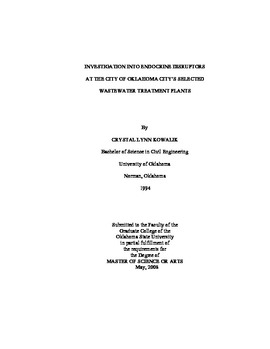| dc.contributor.advisor | Veenstra, John | |
| dc.contributor.author | Kowalik, Crystal Lynn | |
| dc.date.accessioned | 2014-04-17T19:56:09Z | |
| dc.date.available | 2014-04-17T19:56:09Z | |
| dc.date.issued | 2008-05-01 | |
| dc.identifier.uri | https://hdl.handle.net/11244/10138 | |
| dc.description.abstract | Oklahoma City's three largest WWTPs were evaluated for potential vulnerability to EDCs and pharmaceutical pollutants in the influent wastewater streams. A list of candidates for screening was compiled based on potential for occurrence and analytical capability for testing the compounds of interest. Several of the compounds detected include: acetaminophen, caffeine, gemfibrozil (a cholesterol regulator), triclosan (antibacterial agent), sulfamethoxazole (a sulfa-based antibiotic), carbamazepine (anti-anxiety mood stabilizer), progesterone (female hormone), iopromide (iodinated contrast media), trimethoprim (antibiotic), and 4-methylphenol (intermediate organic widely used in industrial processes). In addition to the list of compounds, information regarding common usage, industrial application, and selected chemical properties is provided. The data presented in this report represent a single sampling event, or snapshot, of WWTP water quality. The findings are from a single point in time and do not include influence from factors such as seasonal variation of flow in to the WWTP, changes in treatment (i.e. chlorination/dechlorination), and application of pesticides, fertilizers, etc. by both residential and agricultural users. Concentrations in the plant effluent imply the need for further work to more fully characterize seasonal variability. Few conclusions can be reliably formed without further testing, however, it is clear that some chemicals do appear to pass-through the treatment process at some level. More work needs to be performed to gain a better understanding of the potential impacts to Oklahoma City source waters and natural waters of the state. Although the City's WWTPs do not discharge to any of the City's drinking water sources, additional work should be conducted to determine potential impact from upstream activities on the North Canadian River. | |
| dc.format | application/pdf | |
| dc.language | en_US | |
| dc.publisher | Oklahoma State University | |
| dc.rights | Copyright is held by the author who has granted the Oklahoma State University Library the non-exclusive right to share this material in its institutional repository. Contact Digital Library Services at lib-dls@okstate.edu or 405-744-9161 for the permission policy on the use, reproduction or distribution of this material. | |
| dc.title | Investigation into Endocrine Disruptors At the City of Oklahoma Citys Selected Wastewater Treatment Plants | |
| dc.type | text | |
| dc.contributor.committeeMember | McTernan, William | |
| dc.contributor.committeeMember | Brewer, Todd | |
| osu.filename | Kowalik_okstate_0664M_2716.pdf | |
| osu.college | Engineering, Architecture, and Technology | |
| osu.accesstype | Open Access | |
| dc.description.department | School of Civil & Environmental Engineering | |
| dc.type.genre | Thesis | |
